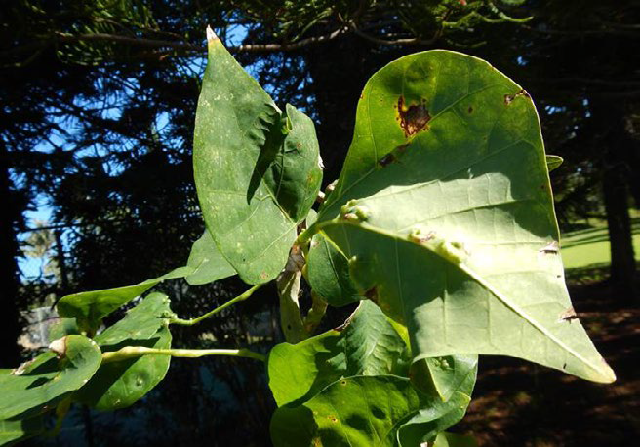By Allyson Earl, Botanical Librarian, Waimea Valley
Invasive plant species dominate large portions of forested area around the world. The Hawaiian Islands, known as the invasion capitol, have been especially hard hit by the introduction of non-native species. Native Hawaiian forests are particularly afflicted from proliferation of invasive plant species. Many of which grow quickly and in dense clumps, which can generate a barrier to regeneration of natives such as Diospyros sandwicensis (lama), Dodonea viscosa(A‘ali‘i),and Erythrina sandwicensis (Wili wili). As non- native species continue to invade Hawaiian forest, land management agencies have worked to protect areas of high native diversity. Waimea Valley on Oahu’s North Shore is doing its part by protecting these native species for future generations. Through propagation and continual care, Waimea has collected some of the most beautiful and incredibly rare native plant species not only for the public to enjoy but to show the
need for ever increasing conservation efforts.
Currently at Waimea Valley, many of the Erythrina trees in our collection are in bloom. This far reaching genus covers the globe from the South Pacific, to Central South America, Africa, and Asia. In most places, it is known colloquially as flame trees or coral trees, among other things, due to the spreading growth of their branches as well as the commonly coral colored flowers. Erythrina trees are in the Legume family or, Fabaceae, as such, these trees create intricate flowers ranging in color from bold reds and blood oranges, to vibrant yellows and soft pinks. Deciduous in nature, these trees lose their fluttering leaves during the dry season and expose their great spiny trunks, which also carry colors from dull browns to sepia orange tones in some species. Holding a special place in our collection is Erythrina sandwicensis, or the Wili
Wili tree. This native Hawaiian tree, whose name means to repeatedly twist in Hawaiian is endemic to the island chain. The twisting of its namesake is in reference to the seed pods of these trees which twist
open to reveal their seeds. The seeds of course come from the charismatic flowers that occur on these
trees. This one species of native Erythrina can have flowers ranging from orange, yellow, salmon, green
and white showcasing its extraordinary variation in color within a species. Traditionally found in the
tropical dry forest throughout the islands, pockets of these trees still remain in nature even on Oahu
adding diversity to the forest on the west side of this island. Not only is this tree important botanically
but is culturally significant as well. It has a place in a hula chant describing the flowers as blooming
during the time when the sharks come close to the shores of the island. Although the chances of seeing
these flowers bloom is more likely than your chance of seeing a shark on our shores. The floatable light
weight wood is used to make surfboards.
These trees with their distinctive spines and fabulous colors are certainly a must see on a trip to Waimea Valley especially as these flowers will only bloom for so long. Although found at Waimea Valley, the numbers of these trees found on the islands is growing smaller every year as dry forest is overtaken by invasive species, such as Erythrina Gall Wasps, homes, and further encroachment into native forestland.
A new invasive insect species, the Erythrina Gall Wasps, was detected in 2004 when people noticed grossly deformed buds and leaves on their wiliwili trees. A wasp from Africa had hitchhiked on a shipment of plants from Taiwan. Once it got here it multiplied furiously feasting on the new growth of every wiliwili it could get to – in dryland forests, yards, and in landscaping and reforestation projects, as it was always considered one of the toughest of our native trees. The arrival of the gall wasp was devastating to farmers, because one sterile variety of Erythrina was used as a windbreak all across Hawai‘i, and it turned out to be the most susceptible, currently the Norfolk Island Pine has taken its place as a windbreak.
Waimea has one of the world’s most diverse collections of trees in the genus Erythrina, so researchers visited Waimea to measure the wasps’ effect on so many different species planted in one place. We noticed that some African species did not develop galls. One of our visitors, Mosman Ramadan, went to Tanzania where he found another wasp that controls the Erythrina gall wasp. University of Hawaii researchers came to Waimea to release the first predator wasps in December of 2008. Many of the natural wiliwili trees in the forests surrounding Waimea Valley were barely hanging on. Since the release of the predator wasps the survival rate of these wiliwili trees in the forest have improved.
However, all is not lost for these natives, many of which are being protected by not only Waimea Valley but by many other conservation organizations throughout the islands working together to protect and share our unique natural resources with the world. Through education and efforts by Waimea Valley and other conservation organizations, we can protect these native species before they are lost forever.



